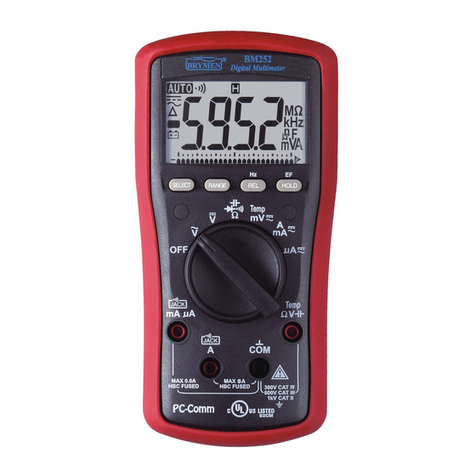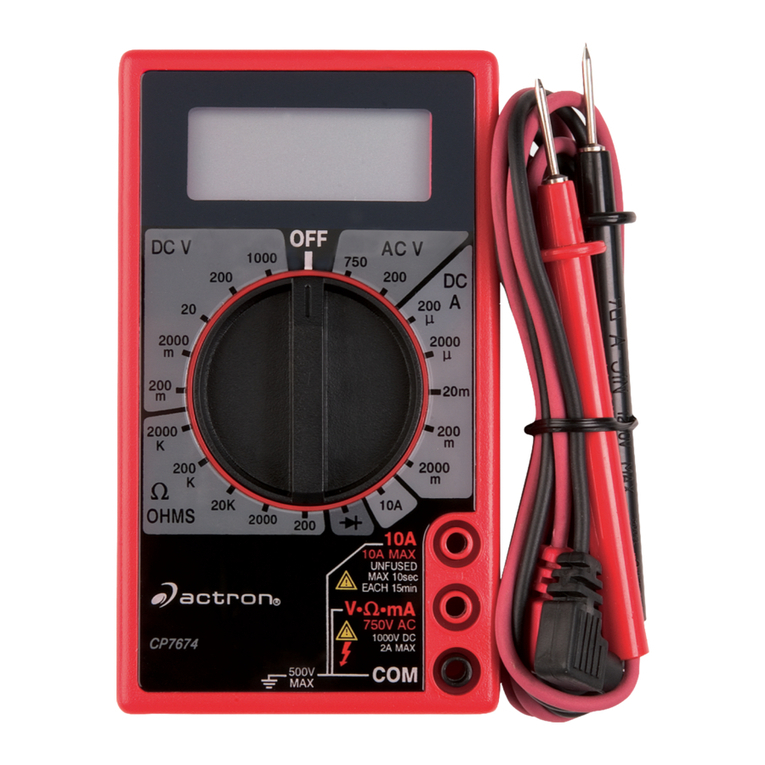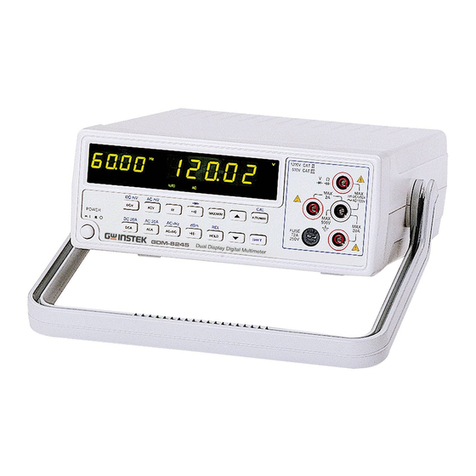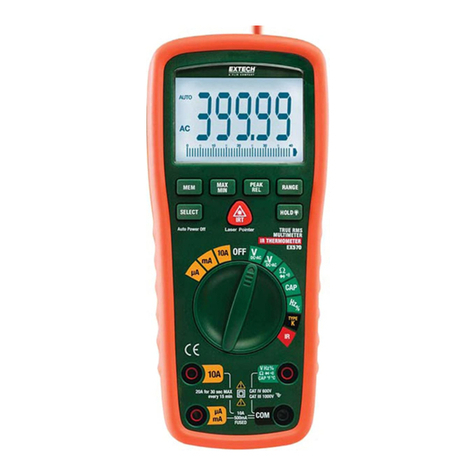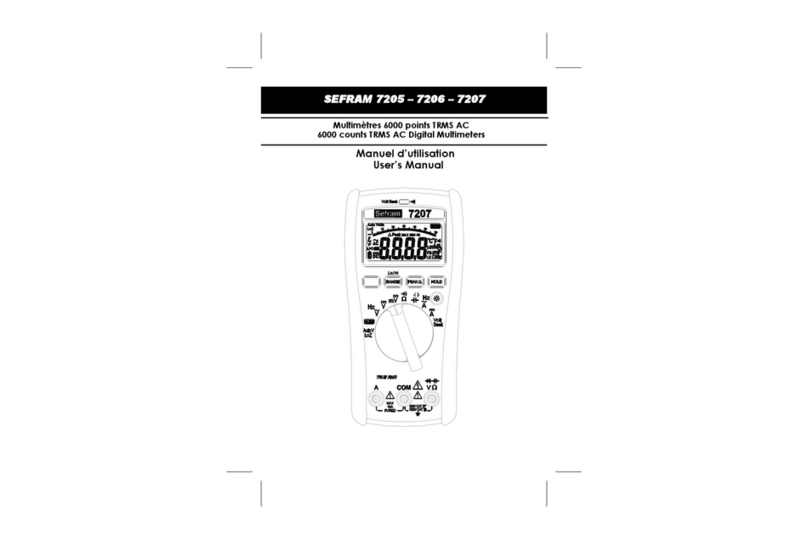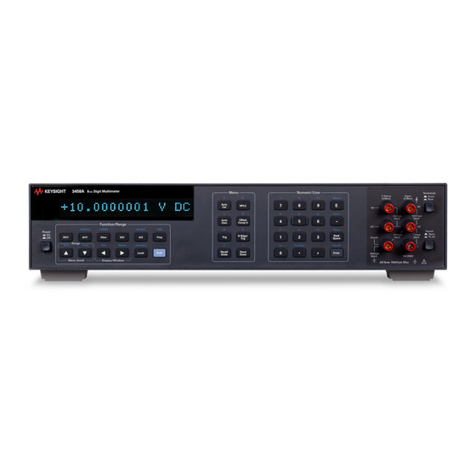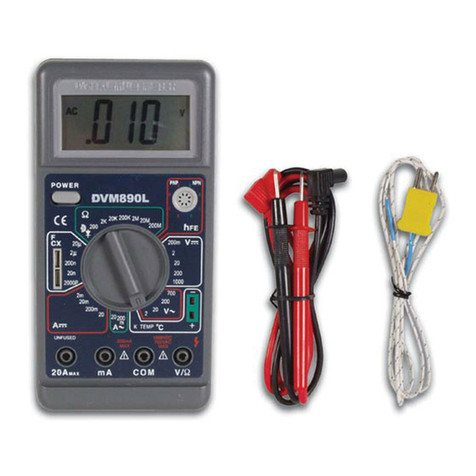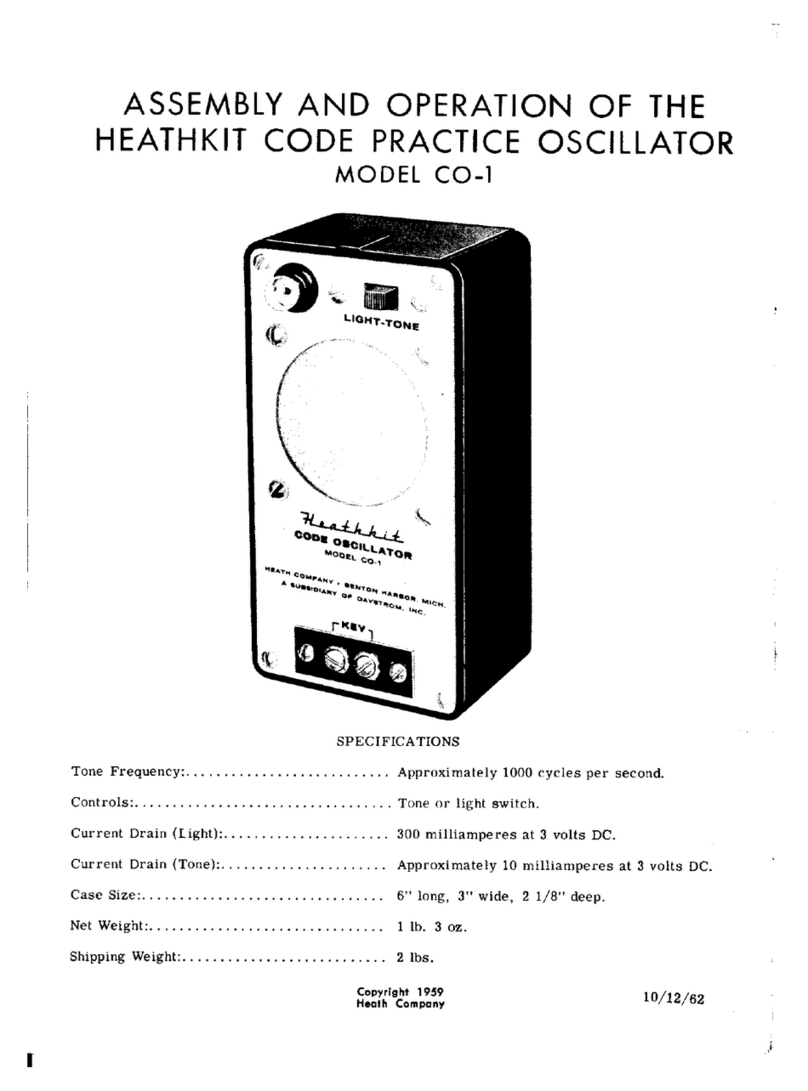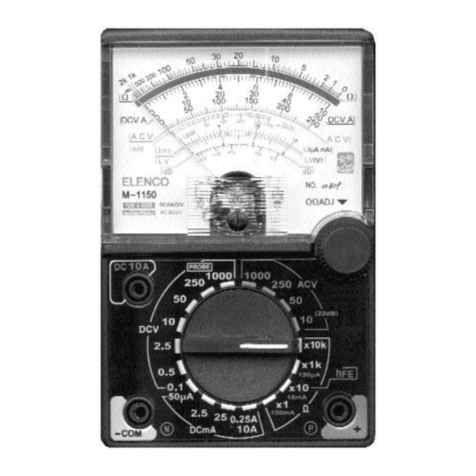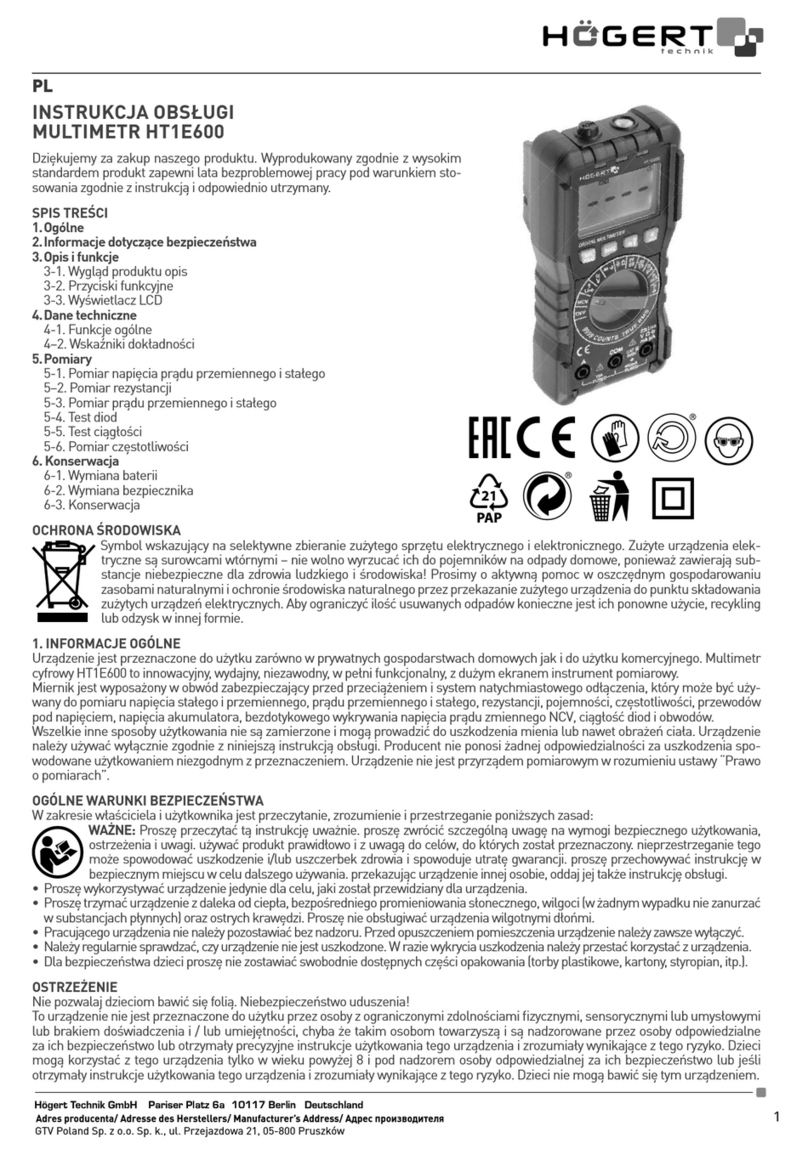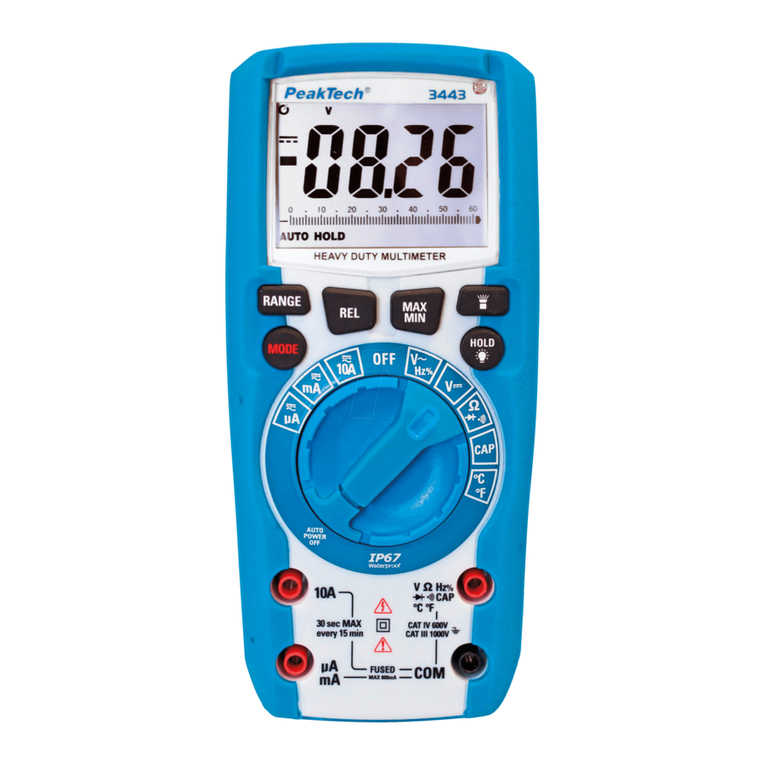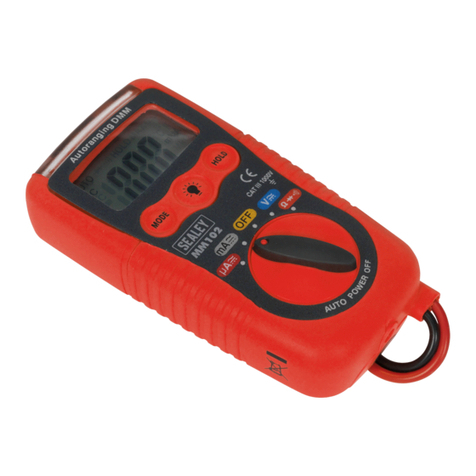General Technologies Corp CT8012 User manual

1. SAFETY RULES
•This meter is designed for indoor use at temperatures between 0°C to 40°C and
altitudes up to 2,000m.
•Toensurethatthemeterisusedsafely,followallsafetyandoperatinginstructionsin
thisoperationmanual.Ifthemeterisnotusedasdescribedinthisoperationmanual,
the safety features of this meter might be impaired.
•Do not use the meter if the meter or test leads look damaged ,or if you suspect that
the meter is not operating properly.
•Whenusingtheinstrument,keepyourfingersbehindthefingerguardsontheplastic
casing and probes.
•Disconnect the live test lead before disconnecting the common test lead.
•Makesurepowerisoffbeforecutting,desoldering,orbreakingthecircuitwires.Small
amounts of current can be dangerous.
•Do not apply more than 500 VDC or 500VAC rms between a terminal and ground.
•To avoid electrical shock, use CAUTION when working above 60V DC or 25V AC
rms. Such voltages pose a shock hazard.
•Never make measurements with the battery cover off.
•To avoid electrical shock or damage to the meter, do not exceed the input limits.
2. INTERNATIONAL SYMBOLS
Important information Dangerous Voltages
see manual Continuity
AC Ground
DC Double Insulation
3. TECHNICAL SPECIFICATIONS
3.1 General Specifications
Display: 3-1/2 digits LCD, max. of 1999 display
Polarity: Automatic, (-) negative polarity indication
Zero adjustment: Automatic
Sample rate: 0.5 Sec.
Over range indication: Only the MSD “1” is displayed
Power: 9-volt battery type NEDA 1604, IEC6F22
Battery life: Approx. 50 hours. (w/ alkaline batteries)
Dimension: 141 x 69 x 36 mm.
Weight: Approx. 330g (including battery).
Accesories: User’s Manual, Alligator Clip, and 9V
alkaline battery
3.2 Electrical Specifications
•The mark next to the probe tip, is a warning that the input
voltage should not exceed the indicated values. This is to pre-
vent personal injuries and damage to the internal circuitry.
•The function switches should be set to the function which you
want to test before operation.
•Accuracies are ±(% of reading + number of least significant
digits) at 23°C ±5°C, less than 75% RH.
4. OPERATION
4.1 INSTRUMENT DESCRIPTION
1) Case
2) 3-1/2 Digit LCD display
3) Range switch
4) Function switch
5) Fixed test lead with probe
6) Fixed probe tip and fuse cap
7) Battery cover
8) Function / Range table
9) Display hold push button (back of the unit)
Function Range Accuracy Input
Impedance
Remarks Overload
Protection
DC Voltage 2000mV,20V,
200V, 600V
0.8%+1 1 M- 600 Vp-p
AC Voltage 200V, 600V 1.5%+10 450 K50~500Hz 600 Vp-p
DC Current 200 mA 2.0%+2 - 200 mA/
250V Fuse
Resistance 2k, 20k,
200k,2000k
1%+3 - - 250 Vp-p
Diode Test Test Current:1.0± 0.6mA Test Voltage: 3.2 V Max. 250 Vrms
Continuity Beeps when < 100Ω3VDC Max. Test Voltage 250 Vrms
4.2 Measurement Procedures
CAUTION: Maximum Input Voltage is 500Vrms,do not exceed
this rating to avoid personal injuries or damage to
the instrument. The range switch should be set to
the range you want to test before the operation.
4.2.1 DC Voltage measurement
12
3
4
5
6
7
89
1 2 3 4
__
200 600
2000m 20 200 600
_
200
_
2K 20K 200K 2000K
1 2 3 4
OFF
mA
MAX
600 V
250 V
GTC
CT8012
V V mA
Ω
Ω
_
Ω
V
V
Set the FUNCTION switch to
V
and the RANGE switch to the
desired range position, according to the Function/Range Table.
Proceed to connect the test leads across the source or load under
measurement. If the voltage range is not known beforehand, set
the range switch to the highest range and work down. The polarity
will be indicated when the tip probe is connected.
4.2.2 AC Voltage measurement
Set the FUNCTION switch to
V
and the RANGE switch to
desired position, according to the Function/Range Table.
Proceed to connect the test leads across the source or load under
measurement, and read the measurement on the LCD screen.
V V mA
Ω
1 2 3 4 OFF
200V
600V
20V
2000mV
FUNCTION RANGE
V V mA
Ω
1 2 3 4 OFF
200V
600V
FUNCTION RANGE
CT8012

4.2.3 DC Current measurement 5. MAINTENANCE
CAUTION: Before attempting battery removal or replacement,
disconnect test leads and remove the instrument
from any energized circuit to avoid shock hazard.
5.1 Battery Replacement
When the battery needs replacement, the battery symbol will
appear in the lower left hand side of the LCD display. To replace the
battery, remove the screw at the back Battery Cover and replace
with a new 9 V alkaline battery type NEDA 1604 or IEC6F22.
5.2 Fuse replacement
To replace the internal fuse, turn the Fuse Cap counter clockwise,
release the Fuse Cap assembly. Take out the blown fuse and replace
with a type IEC60127-2 or UL248-14 (5 x 20mm) fast acting fuse,
rated at 200mA/250V.
5.3 Cleaning
Periodically wipe the case with a soft damp cloth and mild household
cleanser. Do not use abrasives or solvents. Ensure that no water gets
inside the instrument to prevent possible shorts and damage.
6. WARRANTY
One year limited warranty, excluding batteries and fuses. For details
see Standard Warranty Information in our webpage or you may request
a printed copy.
© Copyright 2017 General Technologies
Set the FUNCTION switch to mAand the RANGE switch to the
200mA position. Proceed to connect test leads IN SERIES with the
load in which current is to be measured, and read the measurement
on the LCD screen.
4.2.4 Resistance measurement
CAUTION: Maximum Input Voltage for these functions is 250
Vrms for less than 10 Sec., do not exceed this
rating to avoid personal injuries or damage to the
instrument. Also ensure there is no power applied
to the circuit and all capacitors are discharged.
Set the FUNCTION switch to /and the RANGE switch to
desired krange, if the resistance being measured is connected to
a circuit, turn off power and discharge all capacitors before applying
probes. Proceed to connect the test leads across the component or
circuit under test, and read the measurement on the LCD screen.
4.3 Other Functions
4.3.1 Diode test
Set the FUNCTION switch to /, and RANGE switch to 2K/
position, Proceed to connect the test leads across the diode
observing the polarity: red probe to the anode (+) of the diode and
black test lead to the cathode (-).
4.3.2 Continuity Test
Set the FUNCTION switch to /, and RANGE switch to 2K/
/position, connect test leads across the circuit to be tested.
If resistance is less than approximately 100, the buzzer will be
activated.
4.3.3 Display Hold
A push button switch at the back of the unit is used to hold display
readings during measurements. Pressing and holding the button,
holds the display reading. Releasing the button will resume normal
operation.
FUNCTION RANGE
V V mA
Ω
1 2 3 4 OFF
Ω
FUNCTION RANGE
V V mA
Ω
1 2 3 4 OFF
Ω
FUNCTION RANGE
V V mA
Ω
1 2 3 4 OFF
200m
A
FUNCTION RANGE
1 2 3 4
OFF
200K
Ω
2000K
Ω
20K
Ω
2K
Ω
V V mA
Ω
General Technologies Corp.
#121 - 7350 72nd Street Tel.: (604) 952-6699
Delta, BC V4G 1H9 Fax: (604) 952-6690
Canada www.gtc.ca
Table of contents

